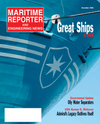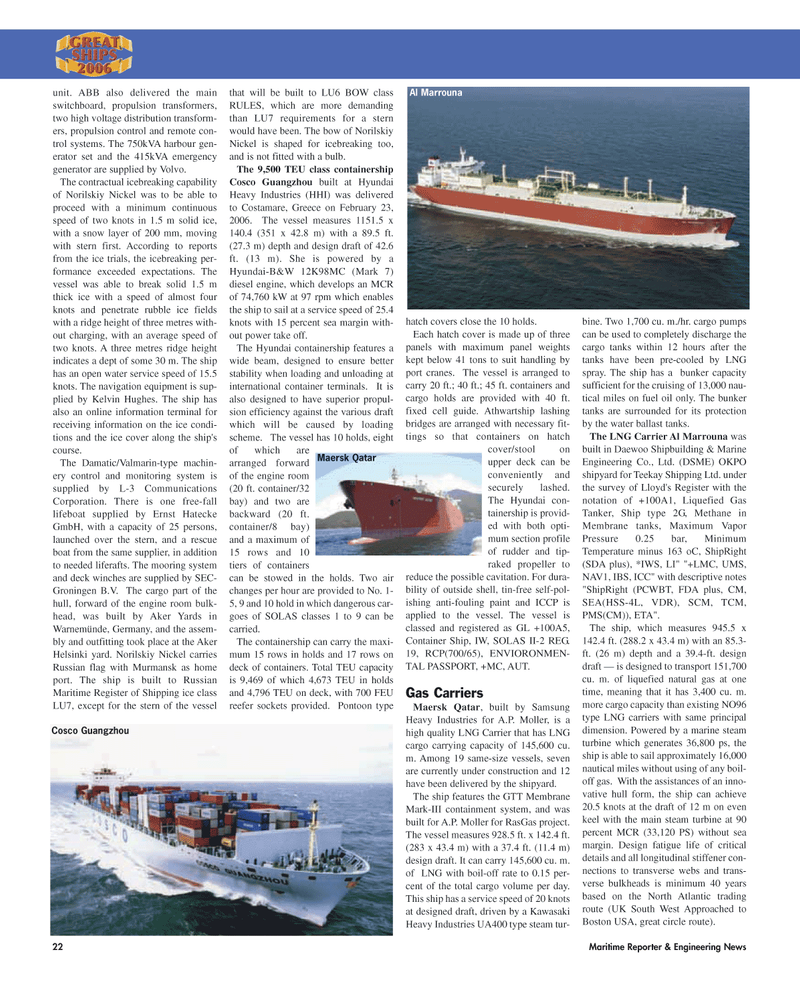
Page 22: of Maritime Reporter Magazine (December 2, 2006)
Read this page in Pdf, Flash or Html5 edition of December 2, 2006 Maritime Reporter Magazine
22 Maritime Reporter & Engineering News unit. ABB also delivered the main switchboard, propulsion transformers, two high voltage distribution transform- ers, propulsion control and remote con- trol systems. The 750kVA harbour gen- erator set and the 415kVA emergency generator are supplied by Volvo.
The contractual icebreaking capability of Norilskiy Nickel was to be able to proceed with a minimum continuous speed of two knots in 1.5 m solid ice, with a snow layer of 200 mm, moving with stern first. According to reports from the ice trials, the icebreaking per- formance exceeded expectations. The vessel was able to break solid 1.5 m thick ice with a speed of almost four knots and penetrate rubble ice fields with a ridge height of three metres with- out charging, with an average speed of two knots. A three metres ridge height indicates a dept of some 30 m. The ship has an open water service speed of 15.5 knots. The navigation equipment is sup- plied by Kelvin Hughes. The ship has also an online information terminal for receiving information on the ice condi- tions and the ice cover along the ship's course.
The Damatic/Valmarin-type machin- ery control and monitoring system is supplied by L-3 Communications
Corporation. There is one free-fall lifeboat supplied by Ernst Hatecke
GmbH, with a capacity of 25 persons, launched over the stern, and a rescue boat from the same supplier, in addition to needed liferafts. The mooring system and deck winches are supplied by SEC-
Groningen B.V. The cargo part of the hull, forward of the engine room bulk- head, was built by Aker Yards in
Warnemünde, Germany, and the assem- bly and outfitting took place at the Aker
Helsinki yard. Norilskiy Nickel carries
Russian flag with Murmansk as home port. The ship is built to Russian
Maritime Register of Shipping ice class
LU7, except for the stern of the vessel that will be built to LU6 BOW class
RULES, which are more demanding than LU7 requirements for a stern would have been. The bow of Norilskiy
Nickel is shaped for icebreaking too, and is not fitted with a bulb.
The 9,500 TEU class containership
Cosco Guangzhou built at Hyundai
Heavy Industries (HHI) was delivered to Costamare, Greece on February 23, 2006. The vessel measures 1151.5 x 140.4 (351 x 42.8 m) with a 89.5 ft. (27.3 m) depth and design draft of 42.6 ft. (13 m). She is powered by a
Hyundai-B&W 12K98MC (Mark 7) diesel engine, which develops an MCR of 74,760 kW at 97 rpm which enables the ship to sail at a service speed of 25.4 knots with 15 percent sea margin with- out power take off.
The Hyundai containership features a wide beam, designed to ensure better stability when loading and unloading at international container terminals. It is also designed to have superior propul- sion efficiency against the various draft which will be caused by loading scheme. The vessel has 10 holds, eight of which are arranged forward of the engine room (20 ft. container/32 bay) and two are backward (20 ft. container/8 bay) and a maximum of 15 rows and 10 tiers of containers can be stowed in the holds. Two air changes per hour are provided to No. 1- 5, 9 and 10 hold in which dangerous car- goes of SOLAS classes 1 to 9 can be carried.
The containership can carry the maxi- mum 15 rows in holds and 17 rows on deck of containers. Total TEU capacity is 9,469 of which 4,673 TEU in holds and 4,796 TEU on deck, with 700 FEU reefer sockets provided. Pontoon type hatch covers close the 10 holds.
Each hatch cover is made up of three panels with maximum panel weights kept below 41 tons to suit handling by port cranes. The vessel is arranged to carry 20 ft.; 40 ft.; 45 ft. containers and cargo holds are provided with 40 ft. fixed cell guide. Athwartship lashing bridges are arranged with necessary fit- tings so that containers on hatch cover/stool on upper deck can be conveniently and securely lashed.
The Hyundai con- tainership is provid- ed with both opti- mum section profile of rudder and tip- raked propeller to reduce the possible cavitation. For dura- bility of outside shell, tin-free self-pol- ishing anti-fouling paint and ICCP is applied to the vessel. The vessel is classed and registered as GL +100A5,
Container Ship, IW, SOLAS II-2 REG. 19, RCP(700/65), ENVIORONMEN-
TAL PASSPORT, +MC, AUT.
Gas Carriers
Maersk Qatar, built by Samsung
Heavy Industries for A.P. Moller, is a high quality LNG Carrier that has LNG cargo carrying capacity of 145,600 cu. m. Among 19 same-size vessels, seven are currently under construction and 12 have been delivered by the shipyard.
The ship features the GTT Membrane
Mark-III containment system, and was built for A.P. Moller for RasGas project.
The vessel measures 928.5 ft. x 142.4 ft. (283 x 43.4 m) with a 37.4 ft. (11.4 m) design draft. It can carry 145,600 cu. m. of LNG with boil-off rate to 0.15 per- cent of the total cargo volume per day.
This ship has a service speed of 20 knots at designed draft, driven by a Kawasaki
Heavy Industries UA400 type steam tur- bine. Two 1,700 cu. m./hr. cargo pumps can be used to completely discharge the cargo tanks within 12 hours after the tanks have been pre-cooled by LNG spray. The ship has a bunker capacity sufficient for the cruising of 13,000 nau- tical miles on fuel oil only. The bunker tanks are surrounded for its protection by the water ballast tanks.
The LNG Carrier Al Marrouna was built in Daewoo Shipbuilding & Marine
Engineering Co., Ltd. (DSME) OKPO shipyard for Teekay Shipping Ltd. under the survey of Lloyd's Register with the notation of +100A1, Liquefied Gas
Tanker, Ship type 2G, Methane in
Membrane tanks, Maximum Vapor
Pressure 0.25 bar, Minimum
Temperature minus 163 oC, ShipRight (SDA plus), *IWS, LI" "+LMC, UMS,
NAV1, IBS, ICC" with descriptive notes "ShipRight (PCWBT, FDA plus, CM,
SEA(HSS-4L, VDR), SCM, TCM,
PMS(CM)), ETA".
The ship, which measures 945.5 x 142.4 ft. (288.2 x 43.4 m) with an 85.3- ft. (26 m) depth and a 39.4-ft. design draft — is designed to transport 151,700 cu. m. of liquefied natural gas at one time, meaning that it has 3,400 cu. m. more cargo capacity than existing NO96 type LNG carriers with same principal dimension. Powered by a marine steam turbine which generates 36,800 ps, the ship is able to sail approximately 16,000 nautical miles without using of any boil- off gas. With the assistances of an inno- vative hull form, the ship can achieve 20.5 knots at the draft of 12 m on even keel with the main steam turbine at 90 percent MCR (33,120 PS) without sea margin. Design fatigue life of critical details and all longitudinal stiffener con- nections to transverse webs and trans- verse bulkheads is minimum 40 years based on the North Atlantic trading route (UK South West Approached to
Boston USA, great circle route).
Cosco Guangzhou
Maersk Qatar
Al Marrouna
MR DECEMBER2006 #3 (17-24).qxd 12/5/2006 2:00 PM Page 22

 21
21

 23
23
